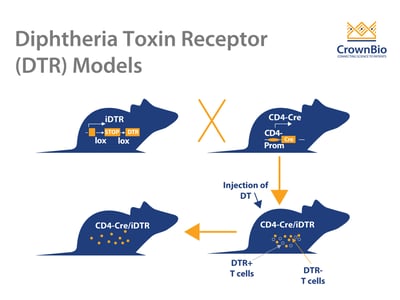Evaluating Immunotherapy Mechanism of Action with Immune Cell Lineage-Specific DTR Models

 Explore how transgenic diphtheria toxin receptor (DTR) preclinical models are used to better understand immunotherapy mechanisms of action and response.
Explore how transgenic diphtheria toxin receptor (DTR) preclinical models are used to better understand immunotherapy mechanisms of action and response.
Using Immune Cell Depletion and Diphtheria Toxin Receptor (DTR) Mouse Models for Immunotherapy Studies
To fully understand (and improve) the response to immunotherapy, and the attrition rate of new agents, a two-pronged approach is needed. Firstly, more predictive and robust preclinical models and methods are needed, to minimize preclinical translational failures in immuno-oncology. Secondly, a deeper understanding of immunological mechanisms of action and biomarker strategies is also needed to minimize immunotherapy clinical failure.
To determine the functional contributions of different cellular components of the immune system, preclinical models have been established where distinct immune cells can be depleted. One important model to selectively deplete cell populations is the diphtheria toxin receptor (DTR) mouse model.
What is Immune Cell Depletion?
Immune cell depletion is a powerful method for determining the functional contributions of different immune system components. The technique is particularly useful for studying underlying mechanisms of cancer immunotherapies, since they often work through multiple mechanisms mediated by different immune cell subsets.
Many preclinical models, such as antibody-mediated approaches and transgenic DTR animals, have been established to deplete distinct immune cells. The use of cytotoxic antibodies for immune depletion is thought to lead to deletion efficiencies in the range of 70–90% (which is dependent on the antibody, cell type, etc.) and various limitations with this approach have been described.
Transgenic DTR strains have been playing an increasingly important role in studies requiring the targeted depletion of specific immune cell populations. These models are particularly useful for depleting lineages that lack cell surface markers typically targeted by monoclonal antibodies.
DTR Mouse Lines for Immune Cell Depletion Studies
Specific immune cell lineages can be depleted using conditional transgenic DTR mouse models, which represent a simple and sensitive method for achieving immune cell lineage ablation. In general, these models are engineered to express DTR downstream of specific cell lineage promoters. Then, upon exposure to DT (which is a strong inhibitor of protein synthesis in growing and non-growing cells) cellular death of the target cell expressing the DTR is induced.
Cre-inducible DTR transgenic mice (iDTR), in which the Cre-mediated excision of a STOP cassette renders cells sensitive to DT, have also been generated and shown to efficiently ablate immune cell lineages after DT exposure.
Some of the existing DTR mouse lines for depleting the most common immune cell lineages include:
FoxP3
FoxP3 is important for T regulatory (Treg) cell lineage specification and function in both mice and humans. Foxp3-DTR mice express knocked-in human DTR and EGFP from the Foxp3 locus with no disruption of endogenous Foxp3 gene expression. These mice are used to deplete Treg cells after administration of DT.
Liu et al. (2016) used this strain to generate tumor-bearing mice with prolonged Treg depletion. The models were used to assess the mechanism, safety, and efficacy of transient Treg depletion in combination with monoclonal antibodies targeting the immunomodulatory receptors PD-1, TIM-3, or CD137. The model effectively recapitulated the spectrum of antitumor responses, as well as grade 3/4 immune-related adverse events (irAEs) that are known to occur in a high proportion of combination immunotherapy-treated patients.
CD4
The CD4-Cre mouse strain is crossed with the Cre-inducible DTR mouse to efficiently generate animals that are depleted of T cells after DT administration.
CD19
The CD19-Cre mouse strain is crossed with the Cre-inducible DTR mouse to efficiently generate animals that are depleted of B cells after DT administration.
CD8
Cd8α is a cell lineage marker for cytotoxic T cells. Cd8α-DTR mice express knocked-in human DTR and EGFP from the Cd8α locus with no disruption of endogenous Cd8α gene expression. These mice are useful for ablation and visualization of CD8+ T cells.
Dendritic Cells (DCs):
Several DTR-based mouse strains have been generated to eliminate DCs and subsets of DCs. For instance, the CD11c-DTR mouse uses the CD11c promoter to guide the DTR expression to DC populations, and when exposed to DT, DC populations are depleted. Other strains include the Itgax-DOC mouse and the Zbtb46-DTR mouse, with other models also available for depleting subsets of DCs.
Several limitations have been noted for the CD11c-DTR mouse, including the toxicity of repeated DT administrations in these animals and the expression of CD11c by non-DCs (e.g. marginal zone macrophages, alveolar macrophages, activated CD8 T cells) and the resulting depletion of these cells after DT administration. Ablation of these other cell types can potentially complicate analyses with this strain.
Natural Killer (NK) cells
NKp46 is selectively expressed by all NK cells (CD49b+ and CD49b−) across multiple species (human, mouse, non-human primate). To achieve selective depletion of NK cells, the NKp46 promoter was used to generate transgenic mice with a NK cell-specific gene expression of DTR, where each DT injection depletes NK cells for a minimum of seven days. This model is effective for preclinical studies looking to evaluate the role of NK cells.
Macrophages
CD11b-DTR mice express human DTR under the control of the human CD11b promoter. A relatively low dose of DT results in macrophage ablation with minimal damage to other mouse cells since the human DTR has a much higher sensitivity to DT than the mouse DTR. While CD11b is expressed on several myeloid lineage cell populations (e.g. macrophages, monocytes, and neutrophils), the administration of DT does not deplete neutrophils.
In addition, other mouse strains, such as the CD169-DTR and CD206-DTR strains, provide ablation of specific macrophage subsets, and these strains may also differentially deplete other myeloid lineages as compared to the CD11b-DTR mouse. These models are effective for preclinical studies looking to evaluate the role of specific macrophage populations.
Conclusion
Diphtheria toxin receptor-based transgenic models represent a very efficient and powerful immune cell depletion option, used to better understand and improve the response to immunotherapy. Prior to selecting a DTR model for immune cell lineage depletion studies, you should consider the goal of your study and the relative advantages and disadvantages of the various DTR transgenic lines discussed here.
Cite this Article
Ludovic Bourré, PhD, (2020) Evaluating Immunotherapy Mechanism of Action with Immune Cell Lineage-Specific DTR Models - Crown Bioscience. https://blog.crownbio.com/evaluating-immunotherapy-with-dtr-models



